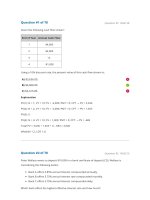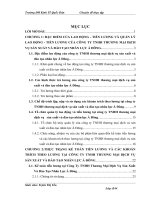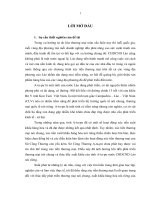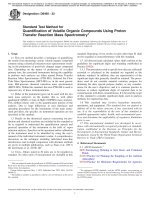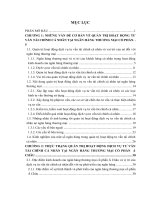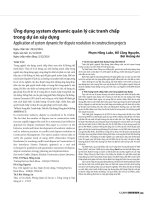Solution manual of environmental chemistry a global perspective 4th ch17
Bạn đang xem bản rút gọn của tài liệu. Xem và tải ngay bản đầy đủ của tài liệu tại đây (147.76 KB, 5 trang )
Solutions: Environmental Chemistry - a global perspective 4th Edition
Chapter 17
The terrestrial environment
PROBLEMS/SOLUTIONS
1.
Consider the terrestrial portions of the global nitrogen cycle (Fig. 15.8). What human activities have
perturbed aspects of this cycle, and in what ways would other processes have to adjust to keep the
cycle in balance?
Solution
The terrestrial portion of the nitrogen cycle includes the lithosphere and part of the biosphere. Nitrogen
inputs to the lithosphere include sedimentation of solids from fresh water and seawater sources,
precipitation from atmospheric sources and mineralization processes from the biosphere. However, the
main human activity that would cause the largest perturbation of the N-cycle would be as a result of the
application of fertilizers. Intense farming practices of the land, the clearing of forests, and increased
pollution of the atmosphere from internal combustion engines would all contribute to perturbations within
the N-cycle.
The N-cycle would necessarily adjust the removal processes to balance these increased inputs from
fertilizers by leaching more N to the lakes and oceans, creating more biological growth or uptake of the
nutrient and increase denitrification processes. A possible positive feed-back would be from precipitation
(with increased HNO3) that ultimately would lead to further cycling of N to the hydrosphere and
lithosphere.
2. The weathering of some clay minerals containing potassium is affected by growing plants. Explain why
this might be so.
Solution
The weathering of clay minerals containing potassium can be affected by growing plants because potassium
is an important macro-nutrient. As such, the reactions associated with the hydrolysis of clay minerals and
the concomitant release of K+ tend to be favoured when the K+ is taken up by the growing plants. In so
doing, the clay mineral will continue to break down at an accelerated rate compared when no plant growth
is occurring.
2KAlSi3O8 (s) + 2H3O+(aq) + 7H2O (l) → Al2Si2O5(OH)4 (s) + 4H4SiO4(aq) + 2K+ (aq)
orthoclase
kaolinite
silicic acid
3.
The surface soil in the humid tropics is often depleted in silica and enriched in iron and aluminium
oxides. In contrast, the surface mineral layer of a forest soil in a temperate region may be devoid of
significant iron and aluminium minerals and have a high concentration of silica. Suggest an
explanation.
Solution
Under conditions of abundant rainfall and elevated temperatures as exists in the humid tropics, the two
processes shown below release soluble silicic acid and solid kaolinite and gibbsite.
149
Solutions: Environmental Chemistry - a global perspective 4th Edition
Chapter 17
The terrestrial environment
2KAlSi3O8 (s) + 2H3O+(aq) + 7H2O (l) → Al2Si2O5(OH)4 (s) + 4H4SiO4(aq) + 2K+ (aq)
orthoclase
kaolinite
silicic acid
Al2Si2O5(OH)4 (s) +
kaolinite
5H2O (l) → 2Al(OH)3 (s) + 2H4SiO4(aq)
gibbsite
silicic acid
Between pH of 2-9 silicic acid will remain fully protonated and be readily soluble and can be mobilized,
leaving behind a soil rich in kaolinite and gibbsite as well as iron oxides.
In the surface mineral layer of a forest soil from the temperate region iron and aluminium are depleted due
to the ability of organic material to complex and solubilize the elements, allowing for their mobilization/
translocation. Acidity, associated with nitrogen fertilizer use, acid precipitation, or from degradation of soil
organic matter as in the case of coniferous forests, may also mobilize aluminium causing it to move
downward in the soil profile. This is an important process in Spodosol formation (Chapter 18).
4.
In an experimental forest, a sample of leaves, weighed over a one year period, is found to lose 83% of
its mass. Assuming first order kinetics, what is the rate constant for their decomposition?
Solution
ln[A] = ln[Ao] – kt
[Ao]
[A]
k
t
(refer to a first year chemistry text)
= 1.00
Note [Ao] – [A] = 0.83 (using relative values)
= 0.17
= rate constant (y-1)
= 1.0 y
ln[0.17] = ln[1.0] – k (y-1) x 1.0 y
– 1.77 = 0 – k
k = 1.77 y-1
The first-order rate constant for their decomposition process is 1.77 y-1.
5.
Using the rate constants provided in the text for degradation of various components of soil organic
matter, compare the time required for degradation to a 10% residual, of tree leaves (mostly cellulose
and hemicellulose) with small twigs (mostly lignin).
Solution
Leafs: The rate constants for degradation of leaves is approximately 0.08 d -1. Using 1.0 gram (C) as the
mass of leaves, how long does it take until there is only 0.1 g of residual leaf matter (10%) remaining.
Use Equation 17.8
dC / dt = - kC
150
Solutions: Environmental Chemistry - a global perspective 4th Edition
Chapter 17
The terrestrial environment
Where dC is the change of mass of the leaves and dt is the change in time. The integrated rate equation then
becomes:
ln (Ct/Co) = - kt
where Co and Ct are initial and remaining amounts respectively.
ln (0.1 g / 1.0 g) = – 0.08 d-1 t
t = 29 d
It takes about 29 days to degrade to 10% leaf matter remaining.
Twigs:
The rate constants for degradation of twigs is approximately 0.01 d -1.
Using 1.0 gram (C) as the mass of twigs, how long does it take until there is only 0.1 g of residual twig
matter (10%) remaining.
dC / dt = – kC
From Equation 17.8
where dC is the change of mass of the twigs and dt is the change in time. The integrated rate equation then
becomes:
ln (Ct/Co) = – kt
where Co and Ct are initial and remaining amounts respectively.
ln (0.1g / 1.0 g) = – 0.01 d-1 t
t = 230 d
The amount of time required for 90% degradation of the twigs is nearly eight times as long as that for the
leaves.
6.
Estimate the total organic nitrogen in 1 tonne of soil that contains 1.5 % organic matter (as humus).
Solution
1.0 t of soil = 1000 kg
1000 kg x 0.015 = 15 kg of organic matter
Organic matter has approximately 5% N (see Example 17.1)
15 kg x 0.05 = 0.75 kg N
The estimated amount of organic nitrogen in 1 tonne of soil containing 1.5% organic matter (as humus) is
about 750 g N.
151
Solutions: Environmental Chemistry - a global perspective 4th Edition
Chapter 17
7.
The terrestrial environment
What are possible feedback processes, related to the forest carbon budget, resulting from increasing
mixing ratios of carbon dioxide in the atmosphere?
Solution
Possible feedback process include 1) increased absorption and uptake of carbon dioxide in Northern forests
(specifically in Russia), 2) sequestration of carbon in forest soils, 3) increased concentrations of aqueous
carbon dioxide in soil pore water, 4) increasing growth rates of trees in general, and 5) forest expansion.
8. The concentration of copper in the surface organic layer of a forest soil is 37 ppm, and in the underlying
mineral layer is 17 ppm. The bulk densities of these two layers are 0.36 and 1.22 g mL –1 respectively.
The very low density of the surface material occurs because it consists in large part of partially
degraded organic material and there is very little of the heavier mineral matter. Which of these two
layers has the higher copper concentration per unit volume?
Solution
37 ppm Cu means 37 g g-1. The Bulk density given is 0.36 g mL-1 for the organic layer, so this means the
concentration per unit volume is:
37 g g-1 x 0.36 g mL-1 = 13 g mL-1
17 ppm Cu means 17 g g-1. The Bulk density is 1.22 g mL-1 for the mineral layer, so this means the
concentration per unit volume is:
17 g g-1 x 1.22 g mL-1 = 21 g mL-1
Despite having a lower amount of copper per gram of soil, the mineral layer has the higher amount of
copper per volume in part due to its much higher density. The mineral layer contains 21 g of Cu per mL
compared to only 13 g of Cu per mL for the organic layer.
9. The concentration of cadmium in the top 15 cm of soil in a field (often called the plough layer) can be
estimated by taking a representative sample, dissolving the soil, and analyzing it by atomic absorption
spectroscopy with electrothermal atomization. The concentration is found to be 0.78 ppm. Suppose that
dewatered (solid) sewage sludge containing 22 ppm cadmium is added at the rate (mass per area) of 3 t
ha–1. Assuming sludge is well mixed within the plough layer, calculate the new average concentration
of cadmium within this part of the soil. The bulk density of the soil is 1.1 g mL –1.
Solution
1 t = 1000 kg, therefore the rate of application is = 3000 kg ha -1
Assume coverage of 1 ha for the calculation.
3000 kg ha-1 x 1 ha = 3000 kg
152
Solutions: Environmental Chemistry - a global perspective 4th Edition
Chapter 17
The terrestrial environment
Therefore 3000 kg of sludge with a concentration of 22 g g-1 of Cd has been added to the plow layer (top
15 cm of 1 ha).
Total amount of Cd added to 1 ha is 3 000 000 g x 22 g g-1 = 6.6x107 g
1 ha = 100 m x 100 m = 10000 m2. The volume of the surface soil we are considering is calculated by
multiplying by the depth of 0.15 m (the plow layer).
which is
100 m x 100 m x 0.15 m = 1.5x10 3 m3
therefore the volume of soil is
1.5x106 L
(1000 L = 1 m3)
(or 1.5x109 mL)
Using the bulk density gives the mass of the soil:
1.5x109 mL x 1.1 g mL-1 = 1.65x109 g of soil in the ‘plow layer’
This layer already contains 0.78 g g-1 of Cd, which means the existing amount of Cd is:
0.78 g g-1 x 1.65x109 g = 1.287x109 µg of Cd
The total Cd in the plow layer is the sum of the newly added Cd plus the existing Cd.
total Cd = 6.6x107 g + 1.287x109 µg = 1.353x109 µg
Cd concentration is: 1.353x109 g 1.653x109 g = 0.82 g g-1
The new average concentration of cadmium in the plow layer is 0.82 g g-1 (or 0.82 ppm). This is only a
slight increase from the initial concentration of 0.78 ppm.
153
